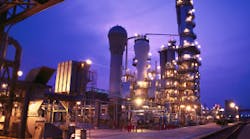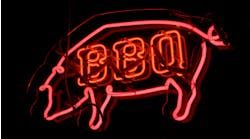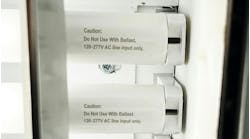Lighting fixtures play a critical role in the safe, efficient, and productive operation of any industrial facility or production process. Darkened, enclosed, and around-the-clock operations rely on them exclusively for illumination. Daylight operations benefit from the spot lighting they provide. However, most facilities, such as petrochemical, food processing, and grain storage, require more from their lighting fixtures. In addition to providing light, fixtures for these industries must address and overcome the inherent challenges of hazardous environments.
Hazardous environment lighting fixtures are designed to specifically handle the highly corrosive elements, combustible dusts, and flammable gases/vapors that are endemic to these industries. This article examines the distinct hazardous environments defined by global electrical codes, which fixtures are suited for them, and technologies that are on the way to help keep light fixtures operating longer and safer. This information provides the foundation for achieving optimal plant safety and efficiency through proper lighting, safe electrical installation, and operation.
Class of threats
The National Electrical Code (NEC) and the Canadian Electrical Code (CEC) divide hazardous environment combustible dusts and flammable gases and vapors into three separate Classes.
- Class I locations are categorized by the flammable gases and vapors present in industries, such as natural gas, petroleum, and chemical.
- Class II locations contain combustible dusts, which can be carried aloft during pulverizing processes or compacted in storage centers. Combustible dusts are found inside plastic, pharmaceutical, coal, and flour processing locations.
- Class III locations contain the ignitable fibers and flyings that are produced in the wood, cotton, and textile industries, among others. They are not explosive in the same sense as some Class I and Class II atmospheres. Additionally, they are not likely to occupy the air enough to be combustible. Instead, ignitable fibers and flyings gather on and around equipment — where a heat source could ignite them.
Class ratings are further broken down into groups, which identify the explosive pressure created by the gas, vapor, or dust (click here to see Table 1). There are three distinct classes of flammable compositions. Class I locations consist of Groups A, B, C, and D:
-
Group A, acetylene, features the highest outward pressure during an explosion.
-
Group B is hydrogen.
-
Group C is ethylene.
-
Group D is gasoline.
Class II locations are divided into Groups E, F, and G based on electrical resistivity charts listed in ANSI/ISA-S 12. 10-1988.
-
Group E is combustible metal dust, such as aluminum and magnesium.
-
Group F consists of coal, printer ink powder, and coke.
-
Group G features agricultural dusts such as cake mix, grain dust, and flour.
Class III locations are not broken into groups.
Define the presence with divisions
NEC/CEC Divisions define hazardous environments by the amount of exposure to the gases, vapors, dusts, or flyings/fibers. Division 1 classifies hazardous atmospheres in which the flammable gas or vapor or combustible dust is present during normal operations or routine maintenance. The existing or potential hazardous atmosphere must also be in the right mixture concentrations to be ignitable. Thus, proper ventilation can change a Div. 1 location in to a Div. 2 location.
Division 2 locations are where hazards are encountered only during an abnormal situation, such as equipment failure or a spill. Locations adjacent to Class I, Div. 1 areas may be deemed Div. 2 as well, to accommodate for the potential seeping of gases or vapors.
Enclosed and gasketed fixtures for Class I, Div. 2, and Class II
Class I, Div. 2 fixtures must be sealed to prevent the hazardous atmosphere from entering the fixture's interior. As such, enclosed and gasketed fixtures are most suitable for this environment.
Class II fixtures also have to function under a blanket of explosive dust as grain silos and other agricultural and mineral processing plants position lights where they can get covered by dust or grains for extended periods of time. These conditions mandate that enclosed and gasketed fixtures prevent dust egress and keep temperatures low. Internal control components must be engineered to radiate less heat. Surfaces need to be contoured to prevent accumulation of dust on the fixture and reduce blanketing. If not engineered properly, exterior light temperatures can soar.
Explosionproof fixtures for Class I, Div. 1, and Class II
Due to the ever-present condition of hazardous gases or vapors, fixtures placed in Class I, Div. 2 and Class II locations must ensure that ignition is never allowed into the environment.
To do this, engineers calculate that the combustible has successfully leaked into the interior of the fixture and has ignited. To prevent the ignition of flammable gases or vapors, explosionproof fixtures feature engineered flamepaths. The flamepaths vent the pressure of an explosion by allowing the gases to escape to the outside atmosphere only after the gas has traveled within the fixture's flamepaths long enough to cool. Cooled gases are released from the flamepaths at temperatures that will not ignite the surrounding flammable atmospheres. Depending on the fixture's design and application, these flamepaths can be incorporated into ground joints, threaded joints, labyrinth paths, close tolerance shafts, interlocking concentric rings, and precision acme/conical threads.
Keeping your cool in hazardous atmospheres
A longer-lasting light is a safer one. It reduces the potential of a maintenance-related accident by stretching out the amount of time between servicing. Simply put, cooler running lamps stay lit longer. That's why it's important to design and manufacture enclosed/gasketed and explosionproof fixtures that reduce the amount of heat they produce.
Light fixture manufacturers do this through electrical, mechanical, and thermal engineering. Electrical engineering looks at the internal control gear placement to reduce the heat buildup produced by these components. Mechanical design uses reflectors to help in heat dispersion while producing higher photometric efficiencies. Thermal designs look at metallurgy techniques and bracket placement to draw heat away from the internal components and out through the casing.
Temperatures to a “T.”
Every hazardous atmosphere has a temperature that, if exceeded, will cause the flammable or combustible to ignite. Accordingly, this temperature, called the “T” rating, is a critical safety benchmark. Hazardous location lighting fixtures must run cooler than the “T” rating of the surrounding atmosphere.
Per the “T” rating chart (Table 2), T1 rated luminaries can only be used in locations where the atmosphere needs a temperature greater that 450°C to ignite. Conversely, T6-rated luminaires run the coolest and can be used in volatile environments where temperatures cannot exceed 85°C anywhere on the fixture.
The “T” rating for a fixture is the temperature of the hottest spot on or in the luminaire depending on the lights' Class or Zone rating. Whether the “T” rating is recorded on or in the luminaire depends on whether it is an explosionproof, flameproof, enclosed and gasketed, or restricted breathing fixture.
For explosionproof and flameproof fixtures, the “T” ratings are measured on the exterior of the fixture. This is due to explosionproof and flameproof lights' ability to disarm any explosion caused within the interior of the fixture. Therefore, the exterior temperature of the fixture becomes the forerunning concern.
Enclosed and gasketed fixtures measure their “T” ratings on the inside. If a hazard is accidentally released into the atmosphere and reaches inside the fixture, it will not ignite, assuming the fixture's “T” rating is below that of the hazard. Restricted breathing fixtures are sealed in the same way as enclosed and gasketed fixtures. They go a step further by having their internal control gear/ballast epoxy sealed. This reduces interior temperatures and contains any accidental sparking, thereby allowing restricted breathing fixtures to have their “T” ratings measured from the outside.
Complex engineering made simple
Unfortunately, the seemingly simple look of enclosed and gasketed and explosionproof lighting can give the wrong impression, which may be one reason why work crews often underestimate the hazardous locations they work in and the engineering of these fixtures. This theory is reinforced by surveys that show maintenance practices usually do not follow standard guidelines. Based on research by IEEE, Paper No. PCIC-2004-47, 80% of the time, fixtures are relamped with the electrical power on. In the 20% of the time the power is turned off, 69% of the relamping occurs as soon as the power is shut off. This does not allow the proper amount of time for many fixtures to cool. Research also shows that 32% of gaskets and seals are not inspected, and maintenance crews are “pretty sure” the gaskets are properly sealed only 55% of the time. Additionally, 95% of the time, luminaires are maintained only after the unit fails.
This reality leads to mistakes that could be avoided. Using the appropriate lamp also contributes to fixture durability and heat buildup. Only lamps of the proper rating for the fixture should be used. For example, a 100W lamp in a 150W fixture can cause the internals to overheat and increase the fixture's “T” rating without any external warning or indication. Using a different lamp voids the fixture warranty, violates the UL-rating, and can put the entire facility and its workers at risk.
Although it's a necessity, when it comes to safely lighting hazardous environments, it's important to understand the potential dangers before implementing a solution. Knowing the facility environment, combustible composition, and fixture application enables the proper lighting design for a safe and productive working environment.
Henry is a manager in the Lighting Division, EGS Electrical Group - Electrical Construction Materials, Rosemont, Ill. He can be reached at [email protected].



